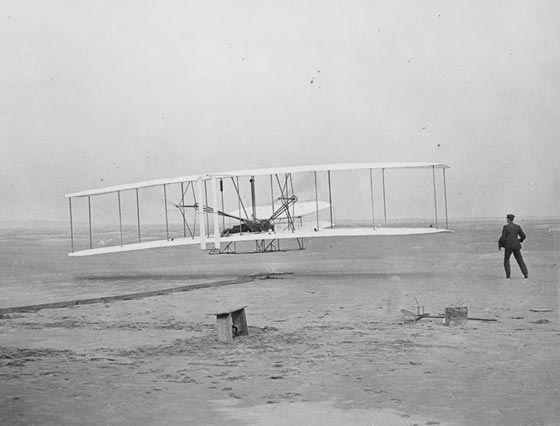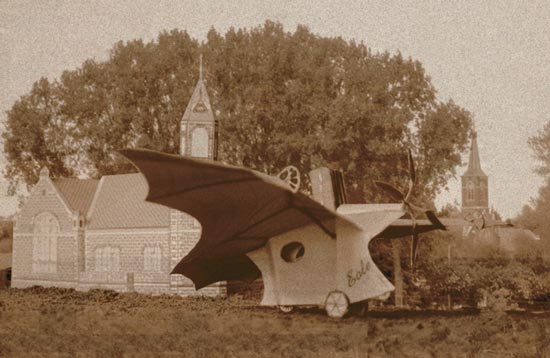First in Flight?
By David Schneider
Were the Wright brothers really the first human beings to fly?
Were the Wright brothers really the first human beings to fly?

DOI: 10.1511/2003.38.0
The centennial of the Wright brothers' famous first flight in 1903 fast approaches. As part of the commemoration, the Smithsonian is opening a special exhibition in which the Wright Flyer, the brothers' pioneering airplane, will be displayed at eye level at the National Air and Space Museum, allowing the interested public to take a close look. On December 17th, exactly 100 years after the fact, at least one of several replicas of the Wright Flyer will attempt a repeat performance over the dunes near Kitty Hawk, North Carolina, with some 25,000 spectators expected to be in attendance. Those organizing various aspects of the national celebration have, of course, had to grapple with a century-old question, one of particular importance at this great moment of national pride: Were the Wright brothers really the first human beings to fly?

National Air and Space Museum, Smithsonian Institution
The short answer, of course, is no. That honor goes to Jean-François Pilâtre de Rozier and (perhaps) the Marquis d'Arlandes, who were lifted by hot-air balloon in 1783. Is the real question, then, whether the Wrights were the first to fly a heavier-than-air craft? Not exactly. Before the Wrights took off in the Flyer, they had gained experience with unpowered gliders, following the example of other pioneering aviators. That is, piloted, heavier-than-air craft were around before the Wrights, some very much resembling the hang gliders now used for recreation. So the question is whether the Wrights were the first to fly a powered, heavier-than-air vehicle—or is it?
A quick investigation into the history of flight reveals numerous reports of piloted, powered flight in heavier-than-air vehicles before the Wright brothers' success. A German immigrant to the United States named Gustave Whitehead (Weisskopf), for example, is said by some to have flown in a home-built, propeller-powered contraption years before the Wrights did. Whitehead's claims are dubious for various reasons, and most aviation historians simply discount them and others of similar ilk. But some of the pre-Wright activity is hard to dismiss as pure invention.
Take the aerial experiments of Augustus Moore Herring. After working under another pioneering aviator, Octave Chanute, with whom he had carried out a number of successful gliding experiments, Herring found independent backing and constructed a biplane hang glider of sorts in 1898, which included a small compressed-air engine. Herring first flew this powered, heavier-than-air craft 50 feet on October 10, 1898, over the lakeside dunes of St. Joseph, Michigan. On October 22, he managed a 73-foot flight, which a newspaper reporter witnessed and described:
During the flight, which lasted eight to ten seconds, Herring’s feet seemed to . . . almost graze the ground, which the machine skimmed along on a level path above the beach. The landing was characterized by a slight turning to the left and slowing of the engine when the machine came gently to rest on the sand.
(Tom D. Crouch, senior curator of aeronautics at the National Air and Space Museum, provided this excerpt from the 1898 newspaper account in his book A Dream of Wings.) Why then is not Herring regarded as first to achieve powered, heavier-than-air flight? Crouch offers one answer: He writes, "Herring's 1898 motorized machine represented nothing more than the culmination of the hang-gliding tradition. Having made his brief powered hops, he found himself at a technological dead end." Of course, the pilots of today's powered hang gliders might have a different perspective. They could reasonably argue that plenty of people are still flying in just this manner, shifting their weight to control their craft, just as Herring and other aviation pioneers had done during the late 19th century, whereas the Wrights operated their Flyer using wing-warping controls rigged to their hips—an awkward scheme no longer found anywhere.
Wright supporters would counter that hip-controlled wing warping inspired more-modern systems of flight control. In any case, one can reasonably ask whether the test of lasting technological merit is fair: Flight is flight, after all. So shouldn't the nation have celebrated the true centennial of flight in 1998?

Guido Van Roy
Further probing into the early history of aviation quickly reveals another possibility: The world should have celebrated in 1990. A hundred years before, a Frenchman named Clément Ader flew a batlike, steam-powered contraption, which he dubbed Eole. Even the U.S. Centennial of Flight Commission (a body created by Congress to commemorate "the centennial of powered flight and the achievements of the Wright brothers' first flight") acknowledges this early accomplishment. Describing Ader's feat on their Web site, under the heading "Efforts at Powered Flight During the Last Decade Before the Wright Brothers," the commissioners state:
Ader tested the Eole on October 9, 1890, over a 656.2-foot (200 meter) prepared surface at the Chateau d'Armainvilliers in Brie, southwest of Paris. Witnesses saw it "hop" about 165 feet (50 meters) as it rose a few inches off the ground, becoming the first manned, steam-powered craft to rise from level ground.
But they are careful to then add a disclaimer line:
However, the flight could not be sustained and did not achieve control.
Again, one might reasonably wonder why a flight must be sustained or achieve control to count for a "first."
Part of the explanation for the Wrights' special place in history is that they went on to improve their airplanes, making them ever more capable, whereas Ader's later craft were failures. Another part is that the American brothers were vigilant to contest rival claims, which would have weakened their position in patent litigation. In particular, they worked hard to refute the early stance of many at the Smithsonian that Samuel Pierpont Langley—a former head of that institution—deserved comparable credit for having previously built a craft capable of powered flight with someone on board. (Having successfully flown various unpiloted craft of this type, Langley made a failed attempt to fly a manned version just days before the Wrights' famous success. A later incarnation of Langley's airplane was flown successfully.) The Wrights' rivalry with Langley explains why, until 1948, the Wright Flyer remained, not at the Smithsonian, but at the Science Museum of London: Orville figured that sending the Flyer to London would make Americans question why it wasn't being displayed in Washington, and he hoped that this would keep pressure on the Smithsonian to accord him and his brother full credit.
Orville's plan worked, but success came only after his death (in January 1948). The contract governing the transfer of the Flyer to Washington required (according to Crouch) that "if the Smithsonian recognized any other aircraft as having been capable of powered, sustained, and controlled flight with a man on board before December 17, 1903, the executors of the estate would have the right to take possession of the machine once again." Thus for many decades now, the Smithsonian hasn't been in any position to champion Langley—or Herring or Ader or anyone other than Orville and Wilbur—in presenting the history of powered flight to the American public.
So are we celebrating the centennial at the proper time? Do the Wrights' December 1903 flights near Kitty Hawk really give the state of North Carolina the right to stamp "First in Flight" on its license plates? The complicated answer may be that a continuum of critical advances in aviation took place during the final decade of the 19th century and the initial decade of the 20th. Picking a single point along that line to celebrate—December 17, 1903—may be a little arbitrary, but it makes for a good national party. And, anyway, there isn't enough room on a license plate to say, "First in Sustained, Piloted, Controlled, Powered, Heavier-than-Air Flight of Lasting Technological Significance."—David Schneider
Click "American Scientist" to access home page
American Scientist Comments and Discussion
To discuss our articles or comment on them, please share them and tag American Scientist on social media platforms. Here are links to our profiles on Twitter, Facebook, and LinkedIn.
If we re-share your post, we will moderate comments/discussion following our comments policy.